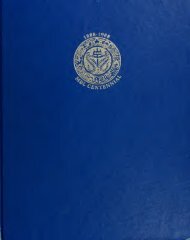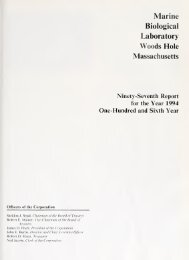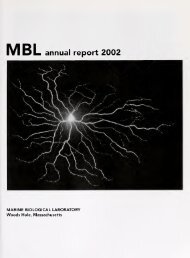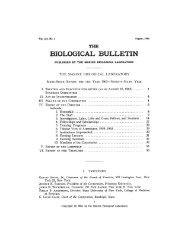12 program profilesengaging undergraduatesSemester in Environmental ScienceIt is a sleepy December morning, but Loeb Laboratory 209 hums with energy.Berkeley student Natalie Levy and Brown student Nicole Travis, a.k.a. “TeamMummishrimp” are tending several aquarium tanks containing varyingcombinations of salt marsh grass, mummichog minnows, and grass shrimpthe students collected from Cape Cod’s marshes and ponds.The tanks are all part of an experiment that is an essential component ofThe Ecosystems Center’s Semester in Environmental Science (SES) program.“We’re looking at whether human-induced habitat changes affect predatorpreyrelationships,” says Levy, who is studying mummichogs, while Travisexperiments with the shrimp they eat.Natalie Levy, <strong>University</strong>of California at Berkeley;Semester in EnvironmentalScience StudentAs their Semester in Environmental Science winds down, Levy andTravis, and the 15 other students in the program, are scrambling to finishindependent projects that count toward their final grades. The experimentsand accompanying fieldwork are a large part of this 15-week program thatprovides expert environmental science instruction and encourages students to“get their feet wet.” And soon the students will present their results in a grandfinale—a day-long symposium like those professional environmental scientistsoften attend.Thanks to a consortium of more than 60 universities, and the innovativeBrown-MBL alliance, which enables the MBL to provide academic credit tostudents from a wide variety of schools around the nation, the SES programattracts some of the brightest young environmental scientists in the country.“Like so many coastal areas, the Cape is being transformed by development, so it providesan ideal site for studying classic ecosystem challenges, such as habitat and biodiversity loss,groundwater contamination, eutrophication and oxygen depletion in aquatic environments,as well as sea level rise and coastal erosion.” — Kenneth Foreman, SES Program Director
program profiles 13Levy, an environmental science major, was drawn to the course because shewanted to learn field biology outside the traditional classroom. And afterweeks of collecting specimens and data in the muddy environs of Falmouth’sWaquoit Bay and Great Sippiwissett marsh, she says the program helped giveher a good sense of what it’s like to be an environmental scientist. “You can’tlearn everything in one place,” she says. “And the SES program provides avery unique opportunity to learn things you couldn’t learn anywhere else.”The diversity of ecosystems on Cape Cod, with its kettle ponds, coastal bays,salt marshes, and oak and pine forests, is, in fact, one of the selling points ofthe course. “It’s a superb natural laboratory,” says program director KennethForeman. “Like so many coastal areas, the Cape is being transformed bydevelopment, so it provides an ideal site for studying classic ecosystemchallenges, such as habitat and biodiversity loss, groundwater contamination,eutrophication and oxygen depletion in aquatic environments, as well as sealevel rise and coastal erosion.”“One day I’d like to work inWashington, using my scientificskills to make a difference at thepolitical level.” — Natalie LevyAdd to the independentresearch a rigorous setof structured lab andfield exercises, engagingclassroom lecturespresented by a facultycomposed of the worldclass researchers at MBL’sEcosystems Center, andinformal dinners withguest lecturers who aresome of the country’smost distinguishedenvironmental scientists,and the result is a perfecttraining ground for the next generationof environmental science leaders andpolicymakers.To be sure, Levy and Travis and theirclassmates had come a long way sincethe first days when they stumbledin the muck, struggling to collectspecimens and data. By the time “Team Mummishrimp” arrived at thesymposium to present experimental results suggesting that habitat changedoes impact mummichog-shrimp interactions and feeding, they had learnedto use many of the tools environmental scientists use regularly. Theyhad grown comfortable in the field. They had mastered skills required tounderstand population and food web dynamics, stable isotope analysis, andbiogeochemistry. And they stood in front of their teachers and peers, coollyanswering tough questions about their findings.BACKGROUND: Offeredsince 1997, the Semester inEnvironmental Science offers anintensive educational experiencefor undergraduates interested ingaining both classroom and fieldexperience in this increasinglyimportant research arena.HOW IT WORKS: A consortiumof more than 60 colleges anduniversities enables the MBLto provide four credits forparticipation in the Semesterin Environmental Science. Ourpartnership with Brown <strong>University</strong>enables us to provide coursecredit to students attending fromschools outside the consortium.RESULTS: Forty percent of SESgraduates pursue graduate orprofessional school related toenvironmental science, education,or policy. Twenty percent are hiredback by The Ecosystems Centerin teaching or research assistantpositions, or they participate inthe center’s Research Experiencefor Undergraduate internships.FUNDERS: The Arthur ViningDavis Foundation, The AndrewW. Mellon Foundation, The StarrFoundationAfter months of hard work, Levy says SES was exactly what she’d hopedfor. “It helped me decide that I want to study environmental science at thespecies level,” she says. “And one day I’d like to work in Washington, usingmy scientific skills to make a difference at the political level.”
- Page 1 and 2: MBL7 MBL StreetNon-profit Org.U.S.
- Page 5: contents1 report of the director an
- Page 8 and 9: 2 report of the director and ceoTha
- Page 10 and 11: 4 program profiles“Our lives are
- Page 12 and 13: 6 program profilesoffering unmatche
- Page 14 and 15: 8 program profilestraining pre and
- Page 16 and 17: 10 program profilesforging powerful
- Page 20 and 21: 14 program profilesexciting k-12 te
- Page 22 and 23: 16 researchresearchThe MBL is one o
- Page 24 and 25: 18 researchgenomes. The National Ae
- Page 26 and 27: 20 researchPublicationsAmaral Zettl
- Page 28 and 29: 22 researchThe High Cost of Coastal
- Page 30 and 31: 24 researchJohn Hobbie Named MBL Di
- Page 32 and 33: 26 researchwhitman centerThe Whitma
- Page 34 and 35: 28 researchA New Twist on Power Wal
- Page 36 and 37: 30 researchfellowshipsMBL Research
- Page 38 and 39: 32 researchAlbert and Ellen Grass F
- Page 40 and 41: 34 researchFriday Evening Lecture S
- Page 42 and 43: 36 researcharchitectural dynamics i
- Page 44 and 45: 38 researchBUMP staff, cont.PH.D. S
- Page 46 and 47: 40 researchmarine resources program
- Page 48 and 49: 42 researchMarine Resources Program
- Page 50 and 51: 44 researchprogram in molecular phy
- Page 52 and 53: 46 researchlaboratory of aquatic bi
- Page 54 and 55: 48 researchlaboratory of norman wai
- Page 56 and 57: 50 educationsummer coursesBiology o
- Page 58 and 59: 52 educationGreenberg, Everett, Uni
- Page 60 and 61: 54 educationMaul, Kristen, City Col
- Page 62 and 63: 56 educationPata, Veena, National I
- Page 64 and 65: 58 educationspecial topics coursesA
- Page 66 and 67: 60 educationMaiato, Helder, Institu
- Page 68 and 69:
62 educationBrower, Stewart, Univer
- Page 70 and 71:
64 educationFACULTYCurran, Sean, Ma
- Page 72 and 73:
66 educationGeunes-Boyer, Scarlett,
- Page 74 and 75:
68 educationSTUDENTSAparicio, Paul,
- Page 76 and 77:
70 educationother educational progr
- Page 78 and 79:
72 educationscholarship awardsIn 20
- Page 80 and 81:
74 educationCaswell Grave Scholarsh
- Page 82 and 83:
76 educationMilton L. Shifman Endow
- Page 84 and 85:
78 mblwhoi librarytrends, and curre
- Page 86 and 87:
80 financialsfinancialsreport of th
- Page 88 and 89:
82 financialsOperating History and
- Page 90 and 91:
84 giftsWe are grateful as well to
- Page 92 and 93:
86 giftsRestricted gifts(up to $9,9
- Page 94 and 95:
88 giftsMEMBER($1,000 - $2,499)Edwa
- Page 96 and 97:
90 giftsJohn E. Hobbie Fund for Sci
- Page 98 and 99:
92 giftsMr. and Mrs. J. Sterling Cr
- Page 100 and 101:
94 giftsLectureshipsJohn J. Cebra L
- Page 102 and 103:
96 gifts10th AnniversaryDr. Eva M.
- Page 104 and 105:
98 giftsMBL AssociatesThe Associate
- Page 106 and 107:
100 giftsMr. James K. TaylorMrs. Al
- Page 108 and 109:
102 giftsMBL Golf OutingIn July, MB
- Page 110 and 111:
104 giftsFellowships Established in
- Page 112 and 113:
106 giftsSemester in Environmental
- Page 114 and 115:
108 governance & administrationgove
- Page 116 and 117:
110 governance & administrationcorp
- Page 118 and 119:
112 governance & administrationDr.
- Page 120 and 121:
114 governance & administrationcoun
- Page 122 and 123:
116 governance & administrationadmi
- Page 124:
118 governance & administrationPhot
















